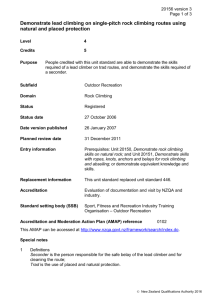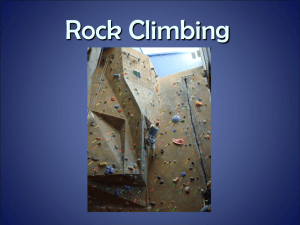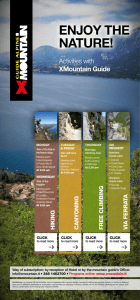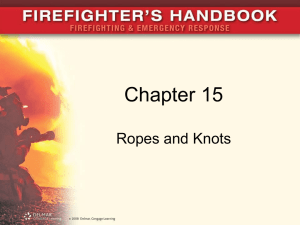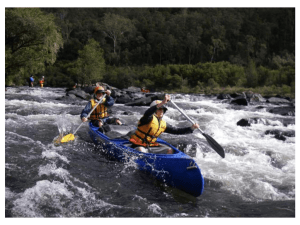Climb - Sentry Marketing Group
advertisement
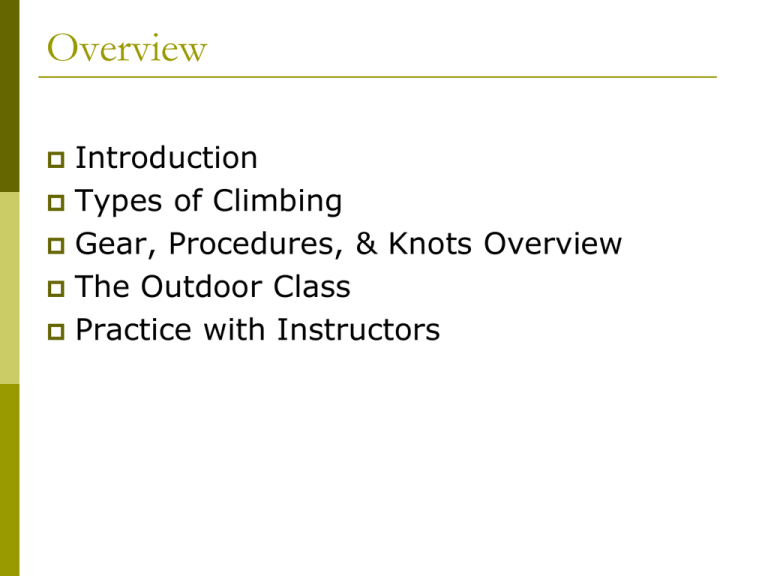
Overview Introduction Types of Climbing Gear, Procedures, & Knots Overview The Outdoor Class Practice with Instructors Who Are the Texas Mountaineers? Formed 1978 as part of Sierra Club Separate Organization in 1988 Nonprofit Organization Conduct 2 Beginners and 1-2 Intermediate Classes each year Emphasize standardized instruction and consensus Best-Safety-Practices Instructors are a mix of highly experienced (20+ years) climbers and more recent class graduates Types of Climbing Hiking and Trekking- trails, scrambling on non-technical rock and snow Classic Mountaineering - rock climbing to 5.6, snow to 40° Bouldering - difficult rock climbing close to ground no rope protection Gym Climbing - climbing on artificial walls Crag Climbing - routes 1 to 3 pitches on difficult rock Top roping - fixed rope (beginner climb) Sport - fixed anchors and protection Traditional “Trad” - placing protection cams, stoppers … Bigwall - climbing bigwalls Yosemite Half Dome Free climbing - No aid using traditional methods Aid climbing - climbing on fixed pieces, Clean aid uses only cams, stoppers … Texas Mountaineers Climbing Scheduled (monthly Sep – May) trips to local crags for top-roping, trad and sport climbing (Texas, Oklahoma, Arkansas) Individual members organize longer trips New Classes for Sport Anchor Cleaning and Sport Leading Trad Intermediate (how to second a leader) Clinics for Anchor Building, Self-Rescue Rock Climb Ratings YDS Description 5.0 – 5.4 Two hands & feet for every move. 5.5 - 5.6 Two hands & feet for every move, not obvious to beginner 5.7 One hand or foot missing 5.8 Missing two, or missing one but strenuous Danger Factors PG Multi-pitch Grades Falls not dangerous I Quick climb R Run out falls not serious II Two to three hours X Run out falls serious III Half day IV All day S Serious unprotected subgrade Ex: 5.11 S9 runout 5.9 move on 5.11 protected crux V Two days VI Multiple days Easy 5.9 Only one hand and one foot 5.10 No obvious hand or foot Intermediate Very Difficult 5.11 Minute hand or foot 5.12 Unfeatured vertical surface or overhanging features 5.13 – 5.15 Overhanging surface with increasingly smaller features Extremely Difficult Climb Ratings Around the World UIAA Germany France USA (YDS) I II 1 III 2 5.2 5.3 3 5.4 HD V- 4 5.5 MS United Kingdom IV V 4+ 5.6 5.7 S V+ 5a 5.8 VS VI- 5b 5c 510a 5.9 HVS 4c VI VI+ 6a 5.10b VII- 6a+ 5.10c E1 6b 6b+ 510d 5.11a E2 Alpine 8,9 10,11 12 13 F PD AD D L WS ZS S UIAA Germany I 5.3 5.4 II 5.5 III VIII 6c 6c+ 7a 7a+ 7b 5.11b 5.11c 5.11d E3 5.12a E4 IX- VIII+ 7b+ 5.12b 5.12c E5 15 16 IX 7c 5.12d IX+ X- X 7c+ 8a 8a+ 8b 8b+ 5.13a 5.13b 5.13c 5.13d 5.14a 5.14b E6 E7 6a 17 18 19 20 TD 5.7 5.8 IV V- V 5.9 V+ XI- 8c 8c+ 9a 5.14c 5.14d E8 22 23 24 25 26 XI E9 XI+ E10 7b 6b 21 7a 27 28 ED 29 30 31 32 33 XD ABO V0 5.6 X+ 6c SS VB 5.2 VIII- 5c 14 Bouldering USA (YDS) VII+ 5b 5a Australia VII V1 510a 5.10b 5.10c 510d 5.11a VI- VI VI+ VII- VII V2 5.11b 5.11c 5.11d VII+ V3 5.12a VIII- V4 V5 5.12b 5.12c VIII VIII+ V6 V7 V8 V9 V10 V11 V12 V13 5.12d 5.13a 5.13b 5.13c 5.13d 5.14a 5.14b 5.14c IX- IX IX+ X- X X+ XI- V14 5.14d XI XI+ Required Gear Bouldering Rock Shoes Chalk Bag Crash Pad ( optional bouldering only) Top Roping Climbing Harness Belay Device / Locking Carabiner Climbing Rope Anchor webbing / static rope / 3 oval Biners / 2 locker Biners Climbing Shoes Lace ups Tight for regular shoe size Toes should lie flat Toes extend to very tip Should be comfortable Velcro Advanced 1 to 1/2 size less Hard Sole Aggressive Sole Climbing Harnesses Belt extend 3” past buckle double back buckle auto locking buckle Gear Loops (always keep belay device, biners, autoblock on the harness) Belay Loop Leg Loops Adjustable – metal buckle Child Full Body Ropes Static Ropes – 3 to 4% stretch Top rope, anchors, hauling Typically 3/8” or 7/16” diameter Dynamic Ropes 6 to 10% stretch; 50, 60 & 70m long Single Ropes 8.9 to 11 mm dia. Double/Half Ropes - 8.1 to 9 mm dia. top rope, sport, trad, bigwall two ropes alternately clipped tied together for long rappels Twin Ropes 8.9 to 11 mm dia. must be clipped together tied together for long rappels Webbing, Accessory Cord, Slings, Quick Draws Accessory Cord 5 or 6 mm Prusik or Autoblock Tubular Webbing Slings TR Anchors Rappel Anchors Sewn Sling Slings Trad Runners Belay / Rappel Devices Screw Gate ATC Reverso Guide Auto-Locking GriGri Large Locking Mini Screw Gate Anchors SRENE Solid: Tree, Bolder, Bolt, Trad Protection Redundant: more than one component Equalized: each component shares the load No Extension: a failure does not shock load the rest 120° 80° 40° 20° 1000 lbs 1000 lbs each 700 lbs each 540 lbs each 500 lbs each Other Anchor Pneumonics SERENE Safe Equalized REdundant No Extension New AMGA acronym ERNEST Equalized, Redundant, No Extension, Strong, Timely Belay Procedure Before Climbing Belayer checks climber is tied in through harness with figure 8 follow through Climber checks belayers rope is through belay device and locking biner and locking biner is locked Climber: On Belay (Are you ready to belay?) Belayer: Belay On (The system is setup properly and I’m ready) Climber: Climbing (The climber is actually stepping on the rock) Belayer: Climb (Final confirmation the Belayer is ready) Belay Procedure Continued During the climb Belayer Never has hand off the belay brake side of the rope Climber: Up Rope (Belayer has let a loop of rope hang below the climber, climber would like less slack, belayer takes up the rope (removes the slack)) Climber: Take (climber is going to weight the rope, belayer tightens rope) Climber: Slack Loosen the rope slightly. Climber: Lower (Used only when top roping) Means lower me to the ground. Both hands on the brake side Other Commands Climber: Off Belay On the ground or anchored at the top of the climb Belayer: Belay Off Rock (Used to warn anyone below of falling objects) Climber: Watch Me Extra belayer attention required due to hard move – Belayer make sure belay is locked off Climber: Falling (climber is falling) Always Perform a Safety Check Check the belayer Harness straps doubled back .. has attached the rope, belay device and carabiner clip in the correct place. Check the ‘live’ end of the rope is above the ‘dead’ end. and always check the screw gate on the carabiner has been locked tight. Always Perform a Safety Check Check the climber Harness doubled back .. has threaded the rope through the correct holes on their harness and always check the knot has been tied correctly. THE BELAY SEQUENCE Start Make a “V” Hand down to the knee One Two Three Knots Figure 8 follow through Double fisherman’s (grapevine) Tying rope to your harness Tying ends of rope or cord Water Knot Tying ends of webbing Knots Prusik Friction knot tying into rope Auto block (Shown) Ascending/Descending rope Backing up Rappel Clove Hitch (intermediate) Tying into Anchor References Mountaineering : The Freedom of the Hills (8th Edition) How to Rock Climb!, 5th Edition (How To Climb Series) by John Long Climbing Anchors Field Guide (How To Climb Series) by John Long and Bob Gaines The Outdoor Class Wichita Mountains Wildlife Refuge Speed Limits Strictly Enforced 45/35 night NO ALCOHOL (vehicles subject to search) Wild Animals have Right-Of-Way Do not bring your pets on this outing. The Refuge is for the animals. Human recreation must not interfere. Climbing permitted only as long as climbers act responsibly. The Outdoor Class Tent Camping at Camp Doris Can arrive anytime Friday PM Directions on Web Site (texasmountaineers.org) Can stay in Lawton Breakfast in Camp Assemble at Group Parking Lot at 8:00 AM Identify groups Leave Group Parking Lot at 8:30 AM The Outdoor Class – Day One Hike into Charon’s Gardens approx. 1 mile Bring everything you need for the day Rain gear/cold weather gear Food and water (3 Liters min/person, more if hot) Climbing Shoes, Harness, Carabiners, Cord Help Carry Club Gear (ropes & webbing) Leave No Trace Take out everything you bring in (ALL trash) Disturb as little as possible Outdoor Class – Day One Anchor Set-up Demonstration by Instructors in Small Groups Top-Roping Climbing and Belay Practice Slab, Crack, and Face Climbing High-Angle Rappel Group Rotates through 5-6 climbing stations Break down climbs and hike out with your Group Dinner – Restaurant in Lawton Outdoor Class – Day Two Break Down Camp Breakfast Options Cook at Camp Doris Drive to Ann’s Café near Mount Scott (leave camp about 7 AM) Drive to the Top of Mount Scott about 8:30 AM Hike down to the climbs Parking lot is easily accessed from crag Do as many climbs as you like, leave at your discretion Practical Instruction Questions? Break into Small Groups
